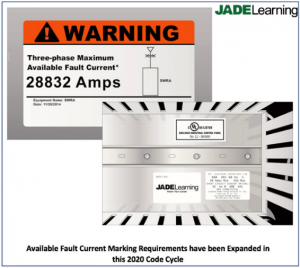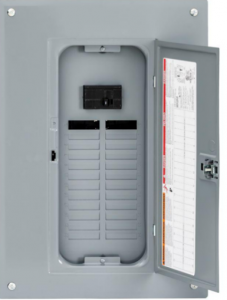Short-Circuit Current-Rating (SCCR) VS. Available Fault Current: Understanding the Maze and What's New for 2020
Published on June 2, 2020 by Jerry Durham
Section 408.6: A Brand-New Addition to the 2020 NEC
NEC section 408.6 states: Switchboards, Switchgear, and Panelboards shall have a short-circuit current rating (SCCR) not less than the available fault current. In other than one- and two-family dwelling units, the available fault current and the date the calculation was performed shall be field marked on the enclosure at the point of supply. The marking shall comply with 110.21(B)(3).
Making NEC 408.6 Simple
This new Code Section simply means that electrical panels including main-breaker and main-lug type panels and switchboards & switchgear equipment must be rated (in amps) to withstand the high levels of current that will flow should a short-to-ground or other fault occur at the equipment. In ALL locations other than dwelling units, that anticipated fault current must be marked on the equipment enclosure near where the supply conductors enter in, along with the date that the calculation producing that number was performed. The new Code Section also says the markings on the equipment must comply with 110.21(B)(3). Section 110.21(B)(3) tells us that markings must be sufficiently durable to withstand the environment.
This new Code Section requiring electricians to mark all Switchboards, Switchgear, and Panelboards is similar to an existing NEC Section (110.24) that demands the same kind of marking but only for service equipment. Service equipment (The First Means of Disconnect) is the equipment that contains the main switch (example: main breaker) that terminates power for all of the premises wiring.

Section 110.24 required that the Available Fault Current be marked on service equipment only (such as main-breaker panels and similar main-switch panels). But newly added Section 408.6 extends that requirement to include every type of panelboard/switchboard/switchgear, at every location except dwelling units. In addition to requiring the Available Fault Current marking on all named enclosures, 408.6 requires the DATE the calculation was performed to be on the enclosure as well. (Note: It does NOT say the calculation must be marked on the equipment, only the DATE the calculation was performed. That is a big difference.)
A Closer Look at the Two Terms Used in 408.6
Section 408.6 in the 2020 NEC tells us: The SHORT CIRCUIT CURRENT RATING (SCCR) of equipment can be no less than the AVAILABLE FAULT CURRENT.
What do these two terms mean?
Short-Circuit Current Rating (SCCR)

Short-Circuit Current Rating (SCCR) is an equipment rating. This rating (in amps) is the equipment's ability to withstand high levels of current that will flow on the grounded metal of the equipment should a short-to-ground or other fault occur. The equipment must be able to withstand this "fault current" without experiencing a meltdown, explosion, or similar catastrophe.
Available Fault Current
Available Fault Current is NOTan equipment rating but is instead the maximum amount of objectionable (unwanted) current that will flow on that equipment, should a fault occur.
Now that we understand these two terms, it is easy to see what is meant in the first sentence of the new Code: Switchboards, Switchgear, and Panelboards shall have a short-circuit current rating (SCCR) not less than the available fault current.
"Available Fault Current" is just one of many terms available to the NEC to describe runaway current at a piece of equipment. There are other terms used by the NEC, so don't get confused if you see them. These include Maximum Fault Current and Available Short-Circuit Current. All of these just mean "Available Fault Current" as it is used in this new Code section, 408.6.
A Simple Rule
Just remember, for all these different and confusing terms only one of them contains the word rating. When you see "rating" as part of the term, as in Short-Circuit-Current-Rating (SCCR), it is referring to equipment, specifically the equipment's ability to withstand explosive fault current. The other terms are just the many ways of referring to this explosive fault current that gets released onto equipment when a fault occurs.
